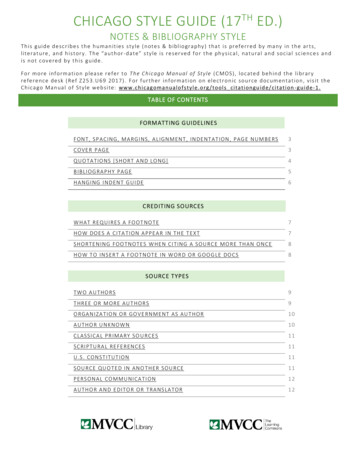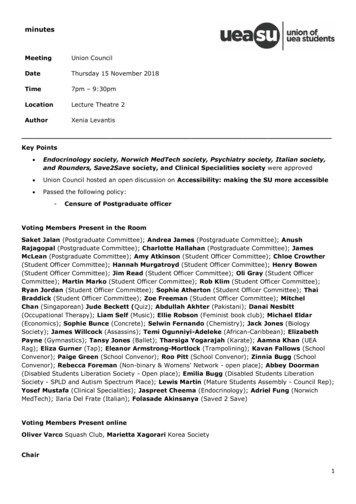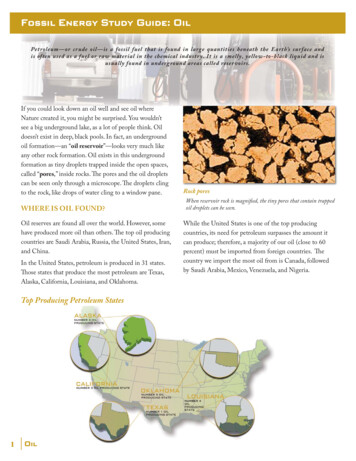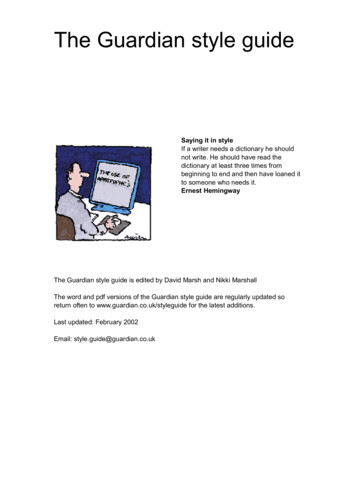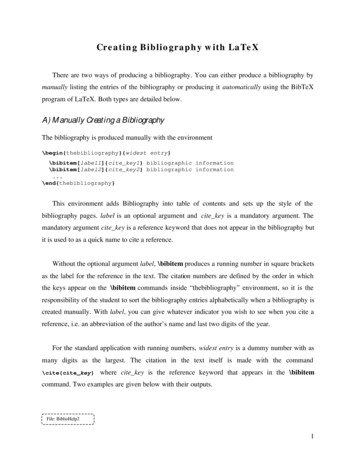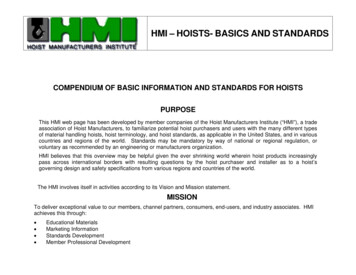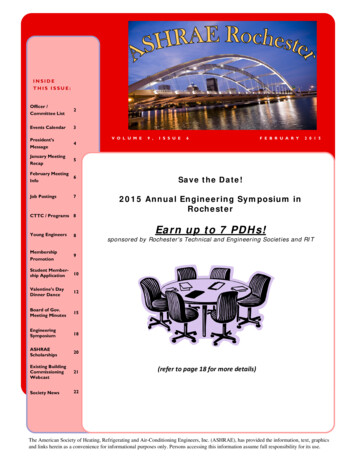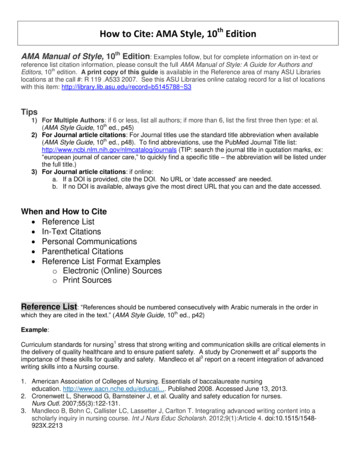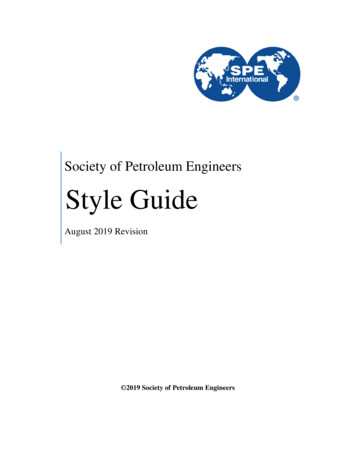
Transcription
Society of Petroleum EngineersStyle GuideAugust 2019 Revision 2019 Society of Petroleum Engineers
SPE Style Guide 2019 Revision ListWelcome to the 2019 revision of the SPE Style Guide. The primary goal of this revision was to better organizethe information in the guide for ease of use, while reducing redundancy. To this end, the guide has beenreformatted into five main parts, with applicable subsections and appendices, rather than a continuous listing ofinterconnected sections. Reformatting comprises the majority of the change to the guide; the following is a listingof additional changes made during revision.1. Complex sentences: Recommended sentence length changed from 25 words to 15–20 words.2. Abbreviations: Limit the use of abbreviations to those used five or more times.3. Jargon: Specialized terms must be defined at first use with a note that the term will be used throughout therest of the publication.4. Units of Measure:a. When using the degree sign ( ), only include a space between the value and degree sign for unitsof API gravity.b. Use “cm3” in place of “mL” to express volume (capacity).5. Titles and Headings: Removed the stipulation that any word of four or more letters should be capitalized.6. Bylines: Added a note regarding use of first and middle initials vs. full names in bylines.7. Enumeration of Points: Emphasized that numbered or bulleted lists in the Conclusions section of a paperare formatted flush to the left margin, not indented.8. Nomenclature: Note added that if an author chooses to omit the Nomenclature, SPE requires that all symbolsused in the paper be defined clearly with dimensions and units (as applicable) at first mention in the text.9. References:a. Updated the digital object identifier (DOI) information to reflect the new standard https://doi.org/.b. Added rules for alphabetical listing of references.c. Added Appendix G: SPE Reference Style Examples.10. Appendices: Section 2.7 was added to clarify use of appendices in journal papers.11. Author Biographies:a. Removed prior work history, publications/patents, and SPE service from the required informationfor an author biography.b. Added SPE membership.c. Changed styling of specific job titles or generalized job duties.12. Common Errors in Usage/Grammar:a. Added use of “a, an” with acronyms.b. Added use of “alternate, alternative.”c. Added use of “definite, definitive.”d. Added use of “disk, disc.”e. Updated use of “due to.”f. Added use of “impact.”g. Added use of “innate, inherent.”h. Added use of “on, upon.”i. Added use of “turbid, turgid, torpid.”
13. Punctuation:a. Removed redundant examples of forming possessives by use of apostrophe.b. Added a note that there is no space between an em dash and the words or numbers on either sideof it.c. Added a note that there is no space between an en dash and the words or numbers on either sideof it.d. Removed bullet regarding use of a hyphen after any prefix if omitting the hyphen will convey thewrong meaning.14. Geographic: Removed the list of cities that can stand alone in text. Moving forward, all cities should includestate/country designations.15. Trademarks: Emphasize that if use of a trademark is used, ownership of the trademark should beacknowledged in a reference or parenthetical insertion.16. Policies and Guidelines:a. Added Section 5.1: Commercialism.b. Added Section 5.2: Use of Copyrighted Material.c. Added Section 5.3: Plagiarism.17. Style Guide Appendices:a. Removed “Christmas tree” from Appendix A: Oil-Industry terms.b. List of organizations moved to Appendix C.c. List of corporate suffixes moved to Appendix C.d. List of reference styles and formatting moved to Appendix G.
ForewordThe Society of Petroleum Engineers (SPE) produces print and electronic publications and marketingmaterials that are distributed to engineers and others in the oil and gas industry worldwide. Because SPEdisseminates technical information for a worldwide readership, clear writing is essential to enhance thecomprehension of SPE publications by readers from a number of geographic areas, nationalities, andlanguage backgrounds.SPE’s rules of style are intended to promote clarity, conciseness, accuracy, and consistency in thesociety’s publications. Guidelines on customary abbreviations, numbering, nomenclatures and referencelists, and punctuation are included in this guide. The Chicago Manual of Style, 17th edition, may also bea helpful reference.While SPE believes that many others may find the guidance in this document helpful, otherpublications or applications may have somewhat different needs that require some differences in style.SPE’s objective in making this style guide available is to help authors and others understand the stylethat SPE uses in its publications. It is not SPE’s intention to try to establish a style that is broadlyapplicable across the oil and gas industry; rather, the intent is to define how SPE will treat stylequestions in its own publications.
Table of ContentsPART I: STYLE AND USAGE . 6Section 1.1: Writing a Good Technical Paper . 6Section 1.2: Spelling . 71.2.1 Compound Words . 71.2.2 Latin Words . 71.3.3 British vs. US Spellings . 71.2.4 Oil-Industry Terms . 7Section 1.3: Abbreviations . 8Section 1.4: Units of Measure . 8PART 2: ELEMENTS OF TECHNICAL PAPERS . 11Section 2.1: Titles and Headings . 11Section 2.2: Bylines . 11Section 2.3: Body . 132.3.1 Typeface . 132.3.2 Enumeration of Points . 142.3.3 Equations . 152.3.4 Citations . 162.3.5 Numbering Tables, Figures, and Equations . 172.3.6 Footnotes . 18Section 2.4: Symbols and Nomenclature . 182.4.1 Nomenclature . 18Section 2.5: Acknowledgments . 19Section 2.6: References . 19Section 2.7: Appendices . 21Section 2.8: Conversion Factors . 21
Section 2.9: Author Biographies . 22Section 2.10: Figures . 23Section 2.11: Tables . 242.11.1 Table Formatting (see also Appendix I: Sample Tables) . 24PART 3: GRAMMAR AND PUNCTUATION . 25Section 3.1: Common Errors in Usage/Grammar . 25Section 3.2: Punctuation . 303.2.1 Comma . 303.2.2 Colon . 303.2.3 Semicolon . 313.2.4 Apostrophe . 313.2.5 Parentheses . 323.2.6 Quotation Marks. 323.2.7 Dashes . 323.2.8 Hyphenation . 343.2.9 Ampersands . 36PART 4: CAPITALIZATION, NUMBERS, AND OTHER RULES OF USAGE . 37Section 4.1: Names . 374.1.1. People, Personal Titles, Degrees . 374.1.2 Companies and Organizations . 384.1.3 Geographic . 394.1.4 Events . 404.1.5 Trademarks . 40Section 4.2: Numbers . 414.2.1 General . 414.2.2 Dates and Times . 42
4.2.3 Phone Numbers . 424.2.4 Whole Numbers. 434.2.5 Fractions . 434.2.6 Currency . 434.2.7 Dimensions . 44PART 5: POLICIES AND GUIDELINES . 45Section 5.1: Commercialism. 45Section 5.2: Use of Copyrighted Material . 45Section 5.3: Plagiarism . 46APPENDIX A: OIL-INDUSTRY TERMS . 47APPENDIX B: COMMON ABBREVIATIONS . 53APPENDIX C: ORGANIZATIONS AND CORPORATE SUFFIXES . 55Section C-1: Organizations . 55Section C-2: Corporate Suffixes . 55APPENDIX D: COMMON OILFIELD UNITS. 57APPENDIX E: MATH SIGNS AND OPERATORS . 58APPENDIX F: GREEK ALPHABET . 59APPENDIX G: SPE REFERENCE STYLE EXAMPLES . 60Section G-1: SPE-Specific Examples . 60Section G-2: Books . 62Section G-3: Journal, Magazine, or Newspaper Articles . 63Section G-4: Miscellaneous . 64APPENDIX H: SAMPLE FIGURES . 68APPENDIX I: SAMPLE TABLES . 69APPENDIX J: BOOKS STYLE . 72Section J-1: Formatting . 72
J-1.1. Textbook Heading Styles. . 72J-1.2. Textbook Example/Problem Styles and Other Issues. . 72Section J-2: Abbreviations and Acronyms . 73J-2.1. Abbreviations. . 73J-2.2. Acronyms. . 73Section J-3: Attribution . 73J-3.1. Attribution for Modified Figures and Tables. . 73J-3.2. Attribution for Redrawn Figures and Tables. . 73J-3.3. Attribution for Republished Figures. 74
PART I: STYLE AND USAGESection 1.1: Writing a Good Technical Paper Use active voice rather than passive voice to produce clearer, more concise writing.Passive voice:An improved method was recommended by the authors.Results of the five experiments are in Fig. 2.Active voice:The authors recommend an improved method.Fig. 2 shows results of the five experiments. Minimize the use of long, complex sentences. Most technical writing experts recommend anaverage sentence length of approximately 15 to 20 words. A mix of long and short sentences and avaried sentence structure are most readable. Limit the use of abbreviations. Use abbreviations sparingly. Limit the use of abbreviations to thoseused often in the article, generally five or more times. Do not abbreviate terms used only once.o When an abbreviation is used, spell out the term at first use, place the abbreviation in parenthesesafter it, and then use the abbreviation in the remainder of the paper or chapter. In journal papers and at the author’s discretion, spell out the abbreviated term again if used asthe title of a section or subsection, or in a figure or table caption. In books, spell out the term at its first use in each chapter; then, continue use of theabbreviation throughout the remainder of the chapter.Note: Rules on the use of abbreviations appear in Section 2. Common oil-industry terms and commonoil-industry abbreviations can be found in Appendices A and B, and a list of common organizationsand company abbreviations can be found in Appendix C. Write concisely. Avoid repeating information. Eliminate unnecessary words and flowery language.A short word is often preferable to a longer word or phrase with the same meaning. Avoid jargon. The specialized term used for an object, place, or method in your geographic area ordiscipline might not be common elsewhere. Use the commonly accepted name or word rather thanlocal industry jargon. If a specialized term is used, define it at first use and note that the term will beused throughout the remainder of the publication.62019 SPE Style Guide
Section 1.2: Spelling1.2.1 Compound WordsIn the growing vocabulary of the industry, many verb/adverb or verb/preposition combinations arecombined into one word. They should be written as two words when used as verbs. For example,workover well vs. to work over the well, at breakthrough vs. water will break through, and builduppressure vs. pressure can build up. Additionally, certain compounds formed by two nouns should bewritten as one word when combined to form an adjective (e.g., casinghead gas vs. the casing head,oilfield problems vs. an oil field, and oilwell tools vs. the oil well).1.2.2 Latin WordsA number of words in English take the Latin plural diaradiicriteriaphenomena1.3.3 British vs. US SpellingsUS spelling conventions are followed for SPE periodicals, books, and most other materials. Paper titlesfor all SPE event programs and proceedings follow whichever English spelling convention the authorelects to use. Programs and other promotional materials prepared for events organized by SPE offices inDubai, Kuala Lumpur, London, and Moscow (and for most events held in Europe, the Middle East, theIndian subcontinent, Africa, and the Asia Pacific region) follow British spelling conventions. SPE eventsorganized from the SPE office in Dallas follow US spelling conventions. All program material,regardless of the responsible office, should be consistent throughout.1.2.4 Oil-Industry TermsPreferred spellings of common oil-industry terms, except as noted in Section 1.2.3, are listed inAppendix A.Note: With “fracturing” appearing commonly in mass media, many news organizations use the verb“fracking.” However, SPE style uses this only when directly quoting someone else; in all other casesthe word “fracturing” is spelled out.2019 SPE Style Guide7
Section 1.3: Abbreviations Abbreviate academic and honorary degrees without periods or spaces. The word “degree” shouldfollow the abbreviation (e.g., PhD degree or MS degree), though it is not necessary in all cases (e.g.,MBA). Abbreviate the names of societies and government agencies without periods or spaces (e.g., SPE,IADC, SPWLA, NPF). Use the following abbreviations for the listed major political entities. Unlike other abbreviations,there is no need to spell out the full name of the political entity at first use.UAE for United Arab EmiratesUS for United States of America (Use USA only when listing a full location, such as Austin, Texas,USA.)UK for United KingdomEU for European Union Abbreviate and capitalize “equation” and “figure” when followed by a number or designating letter(e.g., Eq. 5, Fig. 6). Capitalize but do not abbreviate “table,” “appendix,” “column,” or “section”when followed by a number or designating letter (e.g., Table 1, Appendix A, Column 2, Section 4.1),and do not capitalize or abbreviate “page.” Abbreviate and capitalize “number” when it is part of theproper name of a well (e.g., No. 4), but omit the word in other cases (e.g., Sample 3). Do not use ahashtag symbol (#) as an abbreviation for “number.” With regard to acronyms, leave them all uppercase if they are “true” acronyms, in which each letterstands for an actual word. “False” acronyms are brought into downstyle (i.e., uppercase first letteronly).True Acronym: BOM—bill of materialsFalse Acronym: ANACO—analysis of core logs report Many programming languages, some software applications, and a few other products have theirnames trademarked in all capital letters and are exceptions to the “true” acronyms rule; if the name isa trade name, capitalize the entire name—or the indicated portion of it—according to thetrademarked style (e.g., BASIC, Macintosh OS, COBOL, QuarkXPress, FORTRAN, UNIX).Section 1.4: Units of Measure 8Use only customary (i.e., English system) units or only SI units; do not mix.2019 SPE Style Guide
Exception:Pipe sizes can always be expressed in inches, even if the rest of the text usesmetric units. Abbreviate units of measurement in the text only when used with numerical values (unless theabbreviation replaces a very long phrase, such as “several scf/D” for “several standard cubic feet perday”). A list of preferred abbreviations for oilfield units appears in Appendix D. Consult the SPEMetric Standard for a complete listing of preferred SI units.Examples:25 ft103 ft3/D10 gal 3 cm3Note: Always abbreviate such units in figures and tables. Do not add “s” to abbreviated forms of plural units of measure; use the same abbreviation for bothsingular and plural forms (e.g., 10 bbl, not 10 bbls). Add the “s” when the unit is spelled out (e.g.,darcy/darcies, day/days, ton/tons, and mile/miles).Example: In the experiment, the mass was measured in tons.For units of time in combined units, use the customary abbreviations “sec” (second); “min”(minute); “hr” (hour); “D” (day); and “yr” (year) or the metric abbreviations “s” (second); “min”(minute); “h” (hour); “d” (day); and “a” (year). Otherwise, spell out the term.Examples:42 m/h, but 42 hours34 ft/D, but 34 days12 gal/min, but 12minutes Use abbreviations instead of “ciphers” or symbols to represent customary units of measurement.Examples:Use “lbm” or “lbf,” not a hashtag (#).Use “in.,” not a quote mark (”).Use “ft,” not an apostrophe (’). Express percentages with the percent symbol (%), with no space between the value and the symbol(e.g., 25%, 12 mass%, 21 vol%, 17 mol%, 13 wt%). Use the degree symbol ( ) with angles, temperatures [except for metric K (Kelvin)], and compasscoordinates (e.g., 20 slope, 65 F, 2 W). Only include a space between the value and the degree signfor units of API gravity (e.g., 30 API).2019 SPE Style Guide9
Use the slash (/) in place of “per” between two abbreviated units of measurement (e.g., 40 psi/ft, 15cm/s, 40 lbm/ft).Exceptions:Shots/ft is spelled out at first use, followed by (spf) to indicate its abbreviatedform in further uses.BLPD, BOPD, BFPD, BWPD are exceptions that allow the use of “P” for “per.” Use the hyphen (-) in customary units (e.g., md-ft, B/D-psi) and the product dot ( ) in metric units(e.g., md m, m3/d kPa) to indicate multiplication in combined units. Use “lbm” for pounds mass and “lbf” for pounds force. Use “cm3,” not “cc,” for cubic centimeter. Use “cm3” in place of “mL” to express volume (capacity). Use abbreviations MM for million and M for thousand ONLY with cubic feet to express gasvolumes. Avoid the use of MM with such expressions as barrels of oil (MMBO) or barrel of oilequivalent (MMBOE); instead, spell out “million.”102019 SPE Style Guide
PART 2: ELEMENTS OF TECHNICAL PAPERSAll technical papers will have some, if not all, of the following elements. Title Appendices (as necessary) Byline SI Conversion Factors Body Author Biographies Nomenclature (contingent) Figures Acknowledgments (optional) Tables ReferencesSection 2.1: Titles and Headings In titles and headings in SPE literature, capitalize nouns, pronouns, and adverbs. Also capitalize“no,” “nor,” “off,” “out,” “so,” and “up.” Capitalize words of fewer than four letters if they are averb or part of or closely connected to a verb (e.g., Held Up, To Inject, Can Be Produced). Capitalize both parts of a compound adjective (e.g., Two-Phase, In-Situ, Full-Sized). Use a colon (preferred for titles) or an em dash (acceptable for headings), rather than a comma, toset off part of the title; capitalize the first word after the colon or em dash, and then capitalize asdetailed previously.Examples:Corrosive Service: A Study in EconomicsHorizontal Drilling—New HorizonsSection 2.2: Bylines Bylines on technical papers should include the name of each author, followed by company affiliation.Example:J. B. Brown, Consolidated Flange; P. D. Smith, Smith Consulting; and E. L.White, Worldwide WashersNote: As shown in the above example, use of an author’s first and second initial with full lastname is preferred in bylines. However, the spelling of an author’s name in a byline should reflectthe author’s preference, meaning that full first names can be used instead of first initial. If two or more authors in a row have the same company affiliation, do not repeat it after each name.Example:J. B. Brown, Consolidated Flange; P. D. Smith, Smith Consulting; and E. L.White and P. Lane, Worldwide Washers2019 SPE Style Guide11
Do not rearrange the names of authors in order to simplify or shorten a paper’s author line. The order ofauthors as listed in a technical paper is important; do not change it to simplify company references.Example:J. B. Brown, Consolidated Flange; P. D. Smith, Smith Consulting; E. L. White,Worldwide Washers; and P. Lane, Consolidated Flange If an author’s company affiliation changes during or after the writing of a paper, list the affiliation heldduring the writing of the paper after the author name with the new affiliation following as a footnote.Example:Penny Lane*, Worldwide Washers*now with Consolidated Flange Include corporate suffixes in author bylines, as well as bios, if provided. See Appendix C for a list ofcommon abbreviations for these suffixes. Punctuate bylines properly to avoid confusion of credit or affiliation. Below are examples ofdifferent byline constructions with correct punctuation.o Two people, one company: No comma before the “and.”J. Ford and T. Gibson, Exxon Mobil Corp.o Two people, two companies: Comma before the “and.”J. Ford, Exxon Mobil Corp., and B. Smith, Schlumbergero Three people, three companies: Semicolons to separate, and semicolon before the “and.”J. Ford, Exxon Mobil Corp.; B. Smith, Schlumberger; and K. Moore, BPo X people, two companies: commas to separate, and comma before the “and.”J. Ford, T. Gibson, and S. Johnson, Exxon Mobil Corp., and K. Moore and J. Foster, BPo X people, three or more companies: semicolons to separate, and semicolon before the “and.”J. Ford and T. Gibson, Exxon Mobil Corp.; J. Foster, BP; B. Smith, Schlumberger; and G.White, C. Jones, and S. Kennedy, B&R Consulting. When possible, write a person’s name as he/she writes it. Be aware that the order of names (familyname, given name, etc.) is different in different cultures. Always consider the author’s preference. Do not use department names or university locations in author listings on technical papers. Use thename of the college or university only (which may include a location to differentiate it from anotherbranch of the school).Example:O. Jordan, Texas A&M University; J. Simpson, University of Tulsa; andMahmoud Ali, Texas A&M University-Qatar.122019 SPE Style Guide
Section 2.3: Body2.3.1 Typeface Use bold typeface for such things as authors’ names in bylines and on first use in author biographies;section headings in articles; and first mention of figures and tables.Example: A. C. Clarke, Monolith Communications, and I. Asimov, US Robotics.Example: Arthur C. Cl
lists, and punctuation are included in this guide. The Chicago Manual of Style, 17th edition, may also be a helpful reference. While SPE believes that many others may find the guidance in this document helpful, other publications or applications may have somewha
